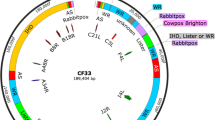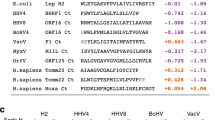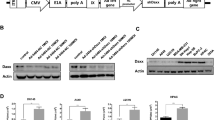Abstract
The oncotropic and oncolytic behaviors of certain autonomous rodent parvoviruses make them promising vectors for anticancer gene therapies. However, these parvoviruses are often not potent enough to kill all tumor cells equally well. With the aim of enhancing the intrinsic antitumor effect and the range of natural parvoviruses, a recombinant H1 parvovirus vector was constructed that produces the Apoptin protein, a tumor cell–specific, p53-independent, Bcl-2–insensitive apoptotic effector. We compared the apoptotic activity exerted by a recombinant hH1/Apoptin virus with that of a Green Fluorescent Protein (GFP)–transducing recombinant virus, hH1/GFP, in three human tumor cell lines differing in their susceptibility to wild-type parvovirus H1–induced killing. We found that in cells that were rather resistant to the basal cytotoxic effect of wild-type H1 or the GFP recombinant virus, a parvovirus that expressed Apoptin caused a pronounced, additional cytotoxic effect. In contrast to its enhanced cytotoxicity toward tumor cells, hH1/Apoptin virus was not more toxic to normal human fibroblasts than was the wild-type H1 virus. Taken together, these data indicate that enhancing the oncotropic behavior of wild-type H1 parvoviruses with the tumor-specific apoptotic potency of Apoptin should lead to an effective replicative parvoviral vector. Cancer Gene Therapy (2001) 8, 958–965
This is a preview of subscription content, access via your institution
Access options
Subscribe to this journal
Receive 12 print issues and online access
$259.00 per year
only $21.58 per issue
Buy this article
- Purchase on Springer Link
- Instant access to full article PDF
Prices may be subject to local taxes which are calculated during checkout
Similar content being viewed by others
References
Rommelaere J, Cornelis JJ . Antineoplastic activity of parvoviruses J Virol Methods 1991 33: 233–251
Rommelaere J, Cornelis JJ . Autonomous parvoviruses In: Driever PH, Rabkin SD, eds. Replication-Competent Viruses for Cancer Therapy, Monographs in Virology Basel: Karger 2001 22: 100–128
Palmer GA, Tattersall P . Autonomous parvoviruses as gene transfer vehicles Contrib Microbiol 2000 4: 178–202
Rayet B, Lopez-Guerrero JA, Rommelaere J, et al . Induction of programmed cell death by parvovirus H-1 in U937 cells: connection with the tumor necrosis factor alpha signalling pathway J Virol 1998 72: 8893–8903
Ohshima T, Iwama M, Ueno Y, et al . Induction of apoptosis in vitro and in vivo by H-1 parvovirus infection J Gen Virol 1998 79: 3067–3071
Moehler M, Blechacz B, Weiskopf N, et al . Selective infection, cell killing and gene transfer of human hepatoma cells but not primary hepatocytes by parvovirus H1 Cancer Gene Ther 2001 8: 158–167
Russell SJ, Brandenburger A, Flemming CL, et al . Transformation-dependent expression of interleukin genes delivered by a recombinant parvovirus J Virol 1992 66: 2821–2828
Kestler J, Neeb B, Struyf S, et al . cis Requirements for the efficient production of recombinant DNA vectors based on autonomous parvoviruses Hum Gene Ther 1999 10: 1619–1632
Danen-Van Oorschot AAAM, Fisher D, Grimbergen JM, et al . Apoptin induces apoptosis in human transformed and malignant cells but not in normal cells Proc Natl Acad Sci USA 1997 94: 5843–5847
Zhuang S-M, Shvarts A, van Ormondt H, et al . Apoptin, a protein derived from chicken anemia virus, induces p53-independent apoptosis in human osteosarcoma cells Cancer Res 1995 55: 486–489
Zhuang S-M, Landegent JE, Verschueren CAJ, et al . Apoptin, a protein encoded by chicken anemia virus, induces cell death in various human hematologic malignant cells in vitro Leukemia 1995 9: Suppl 1 S118–S120
Danen-Van Oorschot AAAM, van der Eb AJ, Noteborn MH . Bcl-2 stimulates Apoptin-induced apoptosis Adv Exp Med Biol 1999 457: 245–249
Danen-Van Oorschot AA, den Hollander Al, Takayama S, et al . BAG-1 inhibits p53-induced but not apoptin-induced apoptosis Apoptosis 1997 2: 395–402
Noteborn MH, Danen-Van Oorschot AAAM, van der Eb MM . Chicken anemia virus: Induction of apoptosis by a single protein of a single-stranded DNA virus Semin Virol 1998 8: 497–504
Pietersen AM, van der Eb MM, Rademaker HJ, et al . Specific tumor-cell killing with adenovirus vectors containing the apoptin gene Gene Ther 1999 6: 882–892
Wetzel K, Menten P, Opdenakker G, et al . Transduction of human MCP-3 by a parvoviral vector induces leukocyte infiltration and reduces growth of human cervical carcinoma cell xenografts J Gene Med 2001 3: 326–337
Graham FL, van der Eb AJ . A new technique for the assay of infectivity of human adenovirus 5 DNA Virology 1973 52: 456–467
Tattersall P, Cawte PJ, Shatkin AJ, et al . Three structural polypeptides coded for by minite virus of mice, a parvovirus J Virol 1976 20: 273–289
van den Heuvel SJ, Van Laar L, Kast T, et al . Association between the cellular p53 and the adenovirus 5 E1B-55kd proteins reduces the oncogenicity of Ad-transformed cells EMBO J 1990 9: 2621–2629
Faisst S, Faisst SR, Dupressoir T, et al . Isolation of a fully infectious variant of parvovirus H-1 supplanting the standard strain in human cells J Virol 1995 69: 4538–4543
Cornelis JJ, Becquart P, Duponchel N, et al . Transformation of human fibroblasts by ionizing radiation, a chemical carcinogen, or simian virus 40 correlates with an increase in susceptibility to the autonomous parvoviruses H-1 virus and minute virus of mice J Virol 1988 62: 1679–1686
Haag A, Menten P, Van Damme J, et al . Highly efficient transduction and expression of cytokine genes in human tumor cells by means of autonomous parvovirus vectors; generation of antitumor responses in recipient mice Hum Gene Ther 2000 11: 597–609
Telford WG, King LE, Fraker PJ . Comparative evaluation of several DNA binding dyes in the detection of apoptosis-associated chromatin degradation by flow cytometry Cytometry 1992 13: 137–143
Van Pachterbeke C, Tuijnder M, Cosyn JP, et al . Parvovirus H-1 inhibits growth of short-term tumor-derived but not normal mammary tissue cultures Int J Cancer 1993 55: 672–677
Su ZZ, Zuyu L, Lanping G, et al . Inhibitory effect of parvovirus H-1 on cultured human tumour cells or transformed cells Scientia Sinica 1988 31: 69–80
Chen YQ, De Foresta F, Hertoghs J, et al . Selective killing of simian virus 40–transformed human fibroblasts by parvovirus H-1 Cancer Res 1986 46: 3574–3579
Fox E, Moen PTJ, Bodnar JW . Replication of minute virus of mice DNA in adenovirus-infected or adenovirus-transformed cells Virology 1990 176: 403–412
Legrand C, Mousset S, Salome N, et al . Cooperation of oncogenes in cell transformation and sensitization to killing by the parvovirus minute virus of mice J Gen Virol 1992 73: 2003–2009
Telerman A, Tuynder M, Dupressoir T, et al . A model for tumor suppression using H-1 parvovirus Proc Natl Acad Sci USA 1993 90: 8702–8706
Dupont F, Avalosse B, Karim A, et al . Tumor-selective gene transduction and cell killing with an oncotropic autonomous parvovirus-based vector Gene Ther 2000 7: 790–796
Bass LR, Hetrick FM . Human lymphoblastoid cells as hosts for parvoviruses H-1 and rat virus J Virol 1978 25: 486–490
Faisst S, Schlehofer JR, zur Hausen H . Transformation of human cells by oncogenic viruses supports permissiveness for parvovirus H-1 propagation J Virol 1989 63: 2152–2158
Wendtner CM, Nolte A, Mangold E, et al . Gene transfer of the costimulatory molecules B7-1 and B7-2 into human multiple myeloma cells by recombinant adeno-associated virus enhances the cytolytic T cell response Gene Ther 1997 4: 726–735
Leon RP, Hedlund T, Meech SJ, et al . Adenoviral-mediated gene transfer in lymphocytes Proc Natl Acad Sci USA 1998 95: 13159–13164
Le Cesne A, Dupressoir T, Janin N, et al . Intra-lesional administration of a live virus, parvovirus H-1 (PVH-1) in cancer patients: a feasibility study Proc Ann Meet Am Soc Clin Oncol 1993 12: 297 Abstract 970
Giese NA, DeMartino L, Haag A, et al . Autonomous parvovirus-based vectors: potential for the gene therapy of cancer In: Gregoriadis G, McCormack B, eds. Targeting of Drugs Amsterdam: IOS Press 2000 34–52
Acknowledgements
We thank Dr. J. Rohn, Leadd BV for critical reading of our manuscript.
Author information
Authors and Affiliations
Corresponding author
Rights and permissions
About this article
Cite this article
Olijslagers, S., Dege, A., Dinsart, C. et al. Potentiation of a recombinant oncolytic parvovirus by expression of Apoptin. Cancer Gene Ther 8, 958–965 (2001). https://doi.org/10.1038/sj.cgt.7700392
Received:
Published:
Issue Date:
DOI: https://doi.org/10.1038/sj.cgt.7700392
Keywords
This article is cited by
-
Viral genes as oncolytic agents for cancer therapy
Cellular and Molecular Life Sciences (2015)
-
Targeting Gene-Viro-Therapy with AFP driving Apoptin gene shows potent antitumor effect in hepatocarcinoma
Journal of Biomedical Science (2012)
-
Mechanisms of Apoptin-induced cell death
Medical Oncology (2012)
-
Antitumoral activity of parvovirus-mediated IL-2 and MCP-3/CCL7 delivery into human pancreatic cancer: implication of leucocyte recruitment
Cancer Immunology, Immunotherapy (2012)
-
Activation of the human immune system by chemotherapeutic or targeted agents combined with the oncolytic parvovirus H-1
BMC Cancer (2011)



